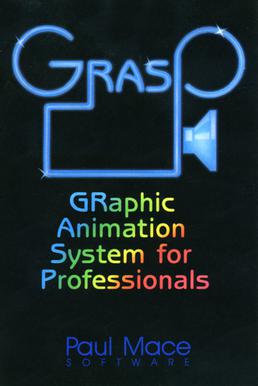
Adobe Flash is a discontinued multimedia software platform used for production of animations, rich internet applications, desktop applications, mobile apps, mobile games, and embedded web browser video players.

Macromedia, Inc., was an American graphics, multimedia, and web development software company (1992–2005) headquartered in San Francisco, California, that made products such as Flash and Dreamweaver. It was purchased by its rival Adobe Systems on December 3, 2005.

Adobe Authorware was an elearning authoring tool with its own interpreted, flowchart-based, graphical programming language. Authorware was used for creating interactive elearning programs that could integrate a range of multimedia content, particularly electronic educational technology applications. The flowchart model differentiated Authorware from other authoring tools, such as Adobe Flash and Adobe Director, which rely on a visual stage, time-line and script structure.

Adobe Creative Suite (CS) is a discontinued software suite of graphic design, video editing, and web development applications developed by Adobe Systems.
Lingo is a verbose object-oriented (OO) scripting language developed by John H. Thompson for use in Adobe Director. Lingo is used to develop desktop application software, interactive kiosks, CD-ROMs and Adobe Shockwave content.
SWF is a defunct Adobe Flash file format that was used for multimedia, vector graphics and ActionScript.

Adobe Shockwave is a discontinued multimedia platform for building interactive multimedia applications and video games. Developers originate content using Adobe Director and publish it on the Internet. Such content could be viewed in a web browser on any computer with the Shockwave Player plug-in installed. MacroMind originated the technology; Macromedia acquired MacroMind and developed it further, releasing Shockwave Player in 1995. Adobe then acquired Shockwave with Macromedia in 2005. Shockwave supports raster graphics, basic vector graphics, 3D graphics, audio, and an embedded scripting language called Lingo.
A Rich Internet Application is a web application that has many of the characteristics of desktop application software. The concept is closely related to a single-page application, and may allow the user interactive features such as drag and drop, background menu, WYSIWYG editing, etc. The concept was first introduced in 2002 by Macromedia to describe Macromedia Flash MX product. Throughout the 2000-s, the term was generalized to describe browser-based applications developed with other competing browser plugin technologies including Java applets, Microsoft Silverlight.
Adobe Flash Player is computer software for viewing multimedia content, executing rich Internet applications, and streaming audio and video content created on the Adobe Flash platform. It can run from a web browser as a browser plug-in or independently on supported devices. Originally created by FutureWave under the name FutureSplash Player, it was renamed to Macromedia Flash Player after Macromedia acquired FutureWave in 1996. It was then developed and distributed by Adobe as Flash Player after Adobe acquired Macromedia in 2005. It is currently developed and distributed by Zhongcheng for users in China, and by Harman International for enterprise users outside of China, in collaboration with Adobe.

Adobe Captivate is an authoring tool that is used for creating eLearning content such as software demonstrations, software simulations, branched scenarios, and randomized quizzes in HTML5 format.
A number of vector graphics editors exist for various platforms. Potential users of these editors will make a comparison of vector graphics editors based on factors such as the availability for the user's platform, the software license, the feature set, the merits of the user interface (UI) and the focus of the program. Some programs are more suitable for artistic work while others are better for technical drawings. Another important factor is the application's support of various vector and bitmap image formats for import and export.

SoundEdit was the first popular GUI-based audio editor for digitized audio. It was one of the first significant audio applications for personal computers in general.

GRaphic Animation System for Professionals (GRASP) was the first multimedia animation program for the IBM PC family of computers. It was also at one time the most widely used animation format.
Jonathan Gay is an American computer programmer and software entrepreneur based in Northern California. Gay co-founded FutureWave Software in 1993. For a decade, he was the main programmer and visionary of Flash, an animation editor for web pages. He founded Software as Art, which was later renamed Greenbox, which made energy management solutions for the home.

Adobe FreeHand was a computer application for creating two-dimensional vector graphics oriented primarily to professional illustration, desktop publishing and content creation for the Web. FreeHand was similar in scope, intended market, and functionality to Adobe Illustrator, CorelDRAW and Xara Designer Pro. Because of FreeHand's dedicated page layout and text control features, it also compares to Adobe InDesign and QuarkXPress. Professions using FreeHand include graphic design, illustration, cartography, fashion and textile design, product design, architects, scientific research, and multimedia production.

Adobe Animate is a multimedia authoring and computer animation program developed by Adobe.

Adobe Shockwave Player was a freeware software plug-in for viewing multimedia and video games created on the Adobe Shockwave platform in web pages. Content was developed with Adobe Director and published on the Internet. Such content could be viewed in a web browser on any computer with the Shockwave Player plug-in installed. It was first developed by Macromedia and released in 1995; it was later acquired by Adobe Systems in 2005.








